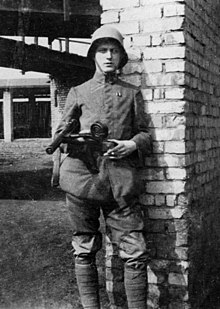
Back قوات الصدمة الألمانية Arabic Sturmtruppen BR Sturmbataillon German Soldado de asalto Spanish Sturmtruppen French חיילי סער HE Stoßtrupp Italian 突撃大隊 Japanese 충격보병 Korean Stormsoldat (tysk stormtrupper) NB
| Sturmtruppen | |
|---|---|
 A stormtrooper poses with his MP 18 and a Luger pistol (France, 1918). Note the characteristic Stahlhelm, modified uniform with reinforcement patches on the elbows and knees and puttees to replace the boots of 1914. | |
| Active | 1916–1918 |
| Country | |
| Branch | |
| Type | Shock troops |
| Role | Anti-tank warfare Artillery observer Close-quarters battle Demining Direct action Hand-to-hand combat Maneuver warfare Patrolling Raiding Reconnaissance Shock tactics Trench warfare |
| Size | 17 battalions (as of 1917)[1] |
| Colors | Green, Grey |
| Equipment | MP 18, Karabiner 98a, Luger pistol, Stahlhelm, Stielhandgranate |
| Engagements | Western Front of World War I |
| Commanders | |
| Notable commanders | Ernst Jünger, Willy Rohr |
Stormtroopers (German: Sturmtruppen[2] or Stoßtruppen[3]) were the only elite shock troops of the Imperial German Army (Deutsches Heer) that specialized in commando style raids, infiltrating the trenches and wiping out the enemy quickly, maneuver warfare, reconnaissance, and shock tactics. In the last years of World War I, Stoßtruppen ("shock troopers" or "shove troopers") were trained to use infiltration tactics – part of the Germans' improved method of attack on enemy trench warfare.[1] The German Empire entered the war certain that the conflict would be won in the course of great military campaigns, thus relegating results obtained during individual clashes to the background; consequently the best officers, concentrated in the German General Staff, placed their attention on maneuver warfare and the rational exploitation of railways, rather than concentrating on the conduct of battles. This attitude made a direct contribution to operational victories of Germany in Russia, Romania, Serbia and Italy, but it resulted in failure in the West. Thus the German officers on the Western Front found themselves in need of resolving the static situation caused by trench warfare on the battlefield.
Two concepts can be identified with the attempt to find a solution to the problem. The first was the belief, mainly held by Erich von Falkenhayn, that tactical action alone, the mere killing of enemy soldiers, was a sufficient means to achieve the strategic goal. The second was the idea, emerging from experience of countless "limited target attacks" and forays into the trenches, that combat had become such a difficult task that operational considerations had to be subordinated to tactical ones. The promoter for this last thesis was General der Infanterie Erich Ludendorff who, having become de facto commander of the Imperial German Army after the German defeat at the Battle of Verdun, gave decisive support to the development of assault battalions as a solution to resume maneuver warfare.[1]
The creation of these units was the first, and perhaps most innovative, attempt by the German army to break out of the impasse of trench warfare. With the use of well-trained soldiers, commanded by NCOs with autonomous decision-making capacity, an attempt was made to traverse no man's land and to break through enemy lines in predefined points in order to allow subsequent waves to liquidate the now confused and isolated opponent, opening large gaps in its defensive systems and then resuming maneuver warfare, which would have allowed Germany to win the conflict.
- ^ a b c Gudmundsson, Bruce I. (1995). Stormtroop Tactics: Innovation in the German Army, 1914-1918. Praeger Paperback. ISBN 0-275-95401-3.
- ^ "Stormtrooper". International Encyclopedia of the First World War (WW1). Retrieved 29 May 2020.
- ^ "Military Developments of World War I". International Encyclopedia of the First World War (WW1). Retrieved 31 May 2020.